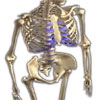What do you know about that fracture?
A fracture in a person over the age of 50 can be a sign of osteoporosis, yet some patient populations have little knowledge of the disease. According to a groundbreaking study published in a recent Journal of Bone and Joint Surgery (JBJS), male and non-English speaking patients tend to have the least knowledge of osteoporosis, putting them at high risk for a subsequent fracture.
Osteoporosis is a contributing factor in as many as 1.5 million fractures each year. The risk of a serious fracture can double after a first fracture in certain high-risk groups. Additionally, many patients, particularly those who suffer hip fractures, are at high risk for premature death or loss of independence after the fracture. Consider these facts from the study:
- One out of four people who have an osteoporotic hip fracture will need long-term nursing home care;
- Those who experience the trauma of an osteoporotic hip fracture have a 24 per cent increased risk of dying within one year following the fracture.
“Many people who sustain a fracture don’t connect it to osteoporosis,” says Angela M. Cheung, MD, PhD, senior scientist at University Health Network/Mount Sinai Hospital Osteoporosis Program in Toronto, Ontario, and one of the authors of the study. “A person who has a heart attack knows that there’s a problem with his or her heart, but a person who fractures thinks, ‘The floor was slippery’ or ‘I’m clumsy’ and doesn’t look at it as a symptom of a more serious medical condition.”
This is especially true for patients in populations that usually aren’t seen as high-risk for osteoporosis, Cheung says.
“Osteoporosis is generally seen as an older, Caucasian women’s disease, but it can affect all races, and men as well. We’re also finding that a lot of fractures for people in their 50s – not elderly at all – are actually fragility fractures (a fracture that occurs from a minimal injury, such as rolling over in bed or stepping hard off a curb), sustained from minimal trauma. We need to improve patient education so these people can be diagnosed correctly and receive appropriate treatment to prevent their next fracture. For example, previous research has shown that male patients have worse outcomes following a hip fracture; a lack of osteoporosis knowledge which we identified in our study could be a significant factor in that.”
Study Details and Important Findings:
- Despite the volume of osteoporosis information currently available, the level of osteoporosis knowledge is low among fracture patients, particularly those who are male, and those for whom English is a second language;
- Patients with fragility fractures knew slightly less about osteoporosis than those with other types of fractures. The study results don’t say for certain that the lack of knowledge in this group led to their fractures, but this finding does reinforce the need for more education, especially since these patients are at the greatest risk of sustaining future fractures;
- Being unemployed, not exercising, and not knowing someone with osteoporosis were also found to be associated with a lower level of knowledge of the disease;
- Patients who had received information from newspapers or magazines knew more about osteoporosis than did those who had received information solely from their healthcare providers. This is likely because many people have difficulty retaining information received in a physician’s office, more so if they have trouble with English;
- Knowing someone with osteoporosis, especially when that person was a family member, was associated with greater knowledge of the disease;
- The study results highlight a clear need to pay special attention to male fracture patients to reduce their risk of future fractures. Also, the finding that fracture patients who speak English as a second language know less about osteoporosis, may not simply reflect communication barriers; rather, it may point to a larger issue of less osteoporosis knowledge among minority populations and people of different ethnic backgrounds.
“Due to the result of this study, we recommend that anyone older than age 50 who has had a fragility fracture, whether a man or a woman, that person should be assessed for osteoporosis,” says Cheung. “We need people to be aware of that connection between fractures and osteoporosis to make sure they get the treatment they need.”
(Source: American Academy of Orthopaedic Surgeons: Journal of Bone and Joint Surgery)
More information
 | For more information on osteoporosis, including its effect on bones and the importance of nutrition and dairy, as well as some useful videos and tools, see Osteoporosis. |
Dates
Tags
Created by:

 Login
Login














